- Yields plunge on fears higher oil prices will heighten inflation
- Commodities and Treasuries jump
- Dollar rally ends
- On Thursday, the US publishes crude oil inventories.
- China PPI and CPI data is released on Thursday.
- The Group of 20 (G20) finance ministers and central bankers meet in Venice on Friday.
- The FTSE 100 index increased 0.4%
- The S&P 500 fell 0.2%
- The NASDAQ 100 rose 0.4% to a record high
- The Dow Jones Industrial Average fell 0.6%, more than any closing loss since June 18
- The MSCI World Index fell 0.3%, more than any closing loss since June 18
- The Dollar Index rose 0.4%, more than any closing gain since June 17
- The British pound fell 0.3% to $1.3802
- The euro slipped 0.3%, more than any closing loss since June 18
- The Japanese yen rose 0.3% to 110.64 per dollar
- The yield on 10-year Treasuries declined seven basis points, more than any closing loss since June 17
- Britain’s 10-year yield declined eight basis points, more than any closing loss in more than 15 months
- Germany’s 10-year yield declined six basis points, more than any closing loss since March 1
- West Texas Intermediate crude fell 1.8%, the most since June 28
- Gold futures rose 0.8%, climbing for the fourth straight day, the longest winning streak since May 20
Key Events
US futures on the Dow, S&P, NASDAQ and Russell 2000 and European shares moved slightly into the green in trading on Wednesday ahead of the release of the FOMC meeting minutes. Traders are waiting to see whether the release will provide any additional clues about the path to higher interest rates and a reduction of the Fed’s expansive asset purchasing program.
The Bitcoin recovery continued.
Global Financial Affairs
All four main US contracts recovered slightly, in line with trading in Europe, after a mixed Asian session. Futures on opposing sides of the reflation trade—represented by the tech heavy NASDAQ 100 and the Russell 2000—underperformed the contracts on the S&P 500 Index and the Dow Jones Industrial Average by a ratio of 2:1.
The market mood ahead of the publication of the Fed minutes at 2.00 PM ET is optimistic. Traders are hopeful that there will be additional detail on why FOMC officials believe the recent hike in inflation is transient. Inflation concerns have been compounded by the recent rally in oil prices which are now at their highest level since 2014 after OPEC+ failed to reach an agreement on additional production.
In Europe, the commodity sector pulled the STOXX 600 Index from a dip into a small advance, as investors increased demand for inflation hedges after the oil price rally.
Major benchmarks in Asia were almost split down the middle, impressive considering Wall Street’s selloff yesterday which broke a multiday rally.
Japan’s Nikkei dropped 0.96%, while Australia’s ASX 200 climbed 0.9%. Hong Kong’s Hang Seng dipped 0.68% while the Shanghai Composite rose 0.66%. The South Korean KOSPI declined 0.6%.
Most surprising was was the advance of China’s Shanghai Composite, considering regulatory moves have dented its tech sector. Regulators imposed stricter data security and other standards on Chinese companies that want to join foreign stock exchanges.
In Tuesday’s session, US stocks whipsawed, plunging first but then paring losses, but still closing well off daily highs. Nevertheless, the S&P 500 Index snapped a 7-day-long winning streak and the Dow Jones a three-day straight advance. The NASDAQ index notched a third consecutive day of climbing in a row.
While the S&P 500 Index closed lower, it did manage to post a new all-time high on an intraday basis, to notch its eighth all time-high in a row, albeit not on a closing basis. 
However, yesterday’s candle on the daily chart denotes weakness.
The S&P 500 posted a hanging man, bearish upon a follow-up candle closing below yesterday’s opening price.
Additionally, the RSI peaked above 70 and dipped, a potential sell signal amid an overbought condition. However, at this point, it is a correction, having neared the top of a rising channel, aiming toward its bottom.
The selloff in stocks was triggered by a plunge in yields, including on the 10-year Treasury note, to the lowest level since February. The move weighed on small caps, as well as banks, thus reducing the prospect of a recovery in the reflation trade.
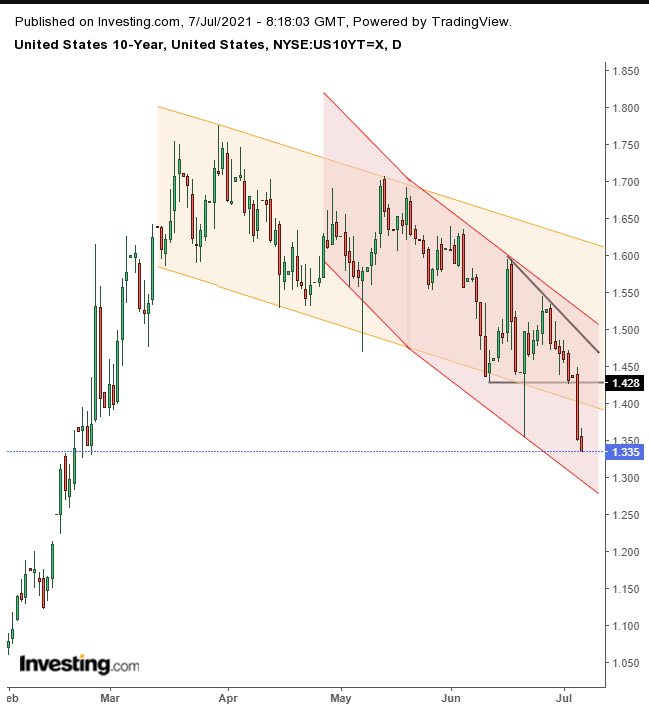
Rates provided the downside breakout of a descending triangle, which helped it break lower than the relatively tempered falling channel through which it was declining. Yesterday’s equity selloff—ending a string of record setting sessions—followed the data release of the Institute of Supply Management, revealing that the service industry expanded less than hoped for.
The dollar edged lower, but it might be starting to develop a falling flag, bullish after the preceding 7-day straight advance, which was the upside breakout of a preceding falling flag.
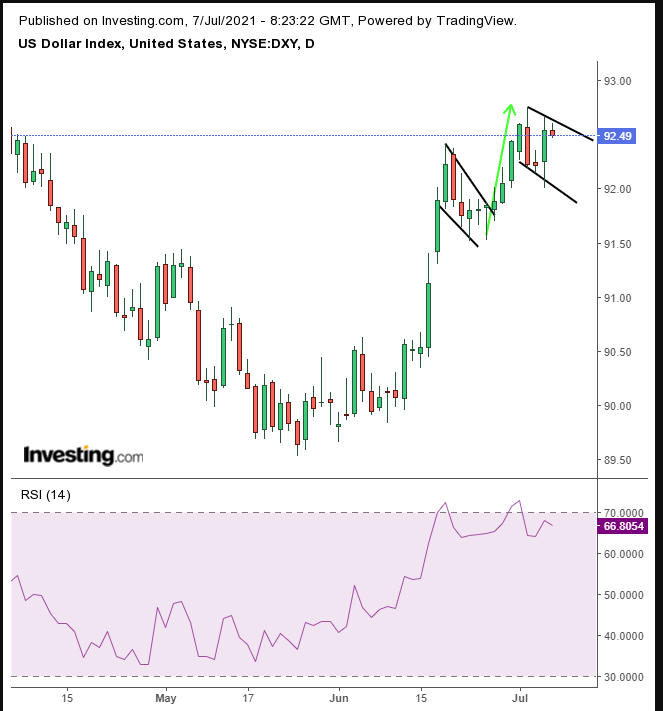
Note, however, the RSI is faltering after hitting overbought levels twice in a row amid the flags’ development.
Investors increased demand for gold amid rising oil prices after the surprise of OPEC+ failing to reach an agreement on raising output.
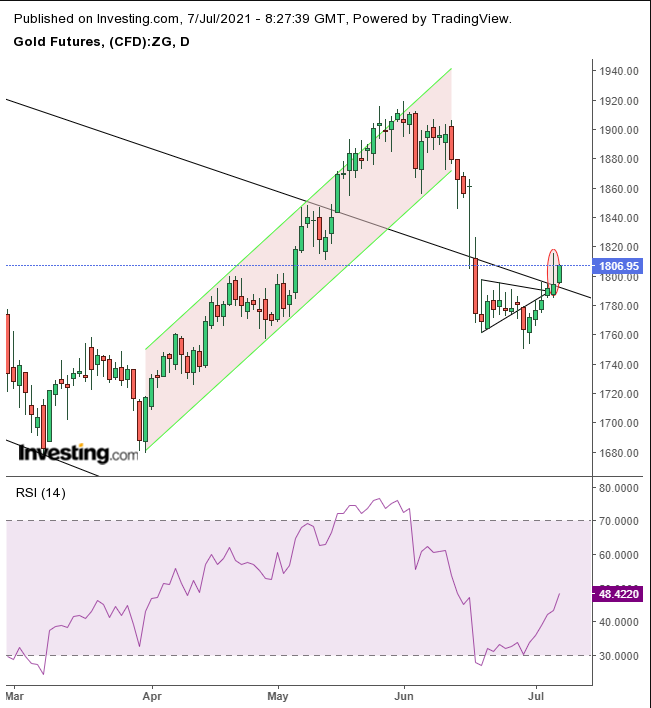
The yellow metal blew out a bearish pennant. Still, yesterday’s candle developed a shooting star with an exceptionally long upper shadow, demonstrating how far the bulls retreated, closing below the top of its falling channel since the 2020 record peak. Meanwhile, the price today is testing the shooting star’s resistance, aided by remaining oversold conditions from the preceding drop and today’s candle developed above and clearing the falling channel top.
Bitcoin is higher for the second consecutive day, as it still trades within a potential H&S continuation pattern.
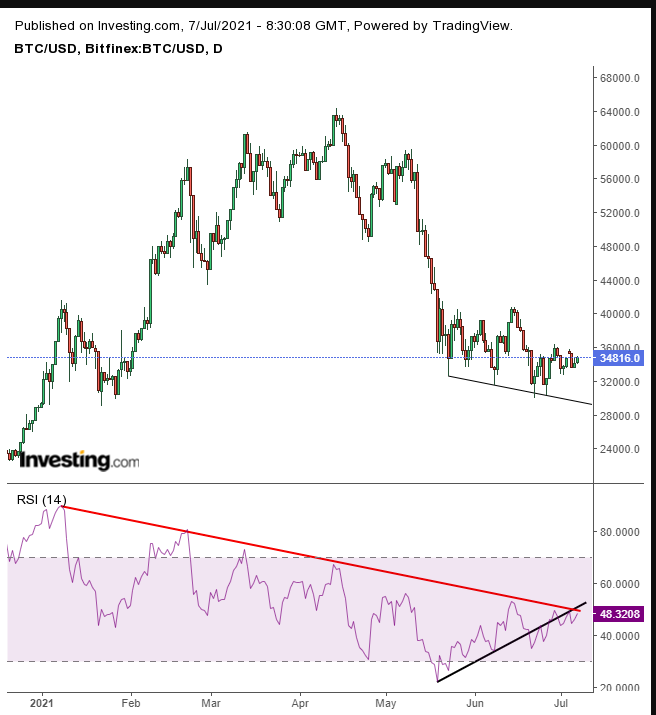
Notice how its momentum has failed to keep up, finding resistance by its own uptrend line, as it meets with the RSI’s downtrend since it provided a negative divergence to rising prices since January.
Oil eased with a sharp selloff after reaching a more than six-year high amid OPEC+ infighting and strong demand. 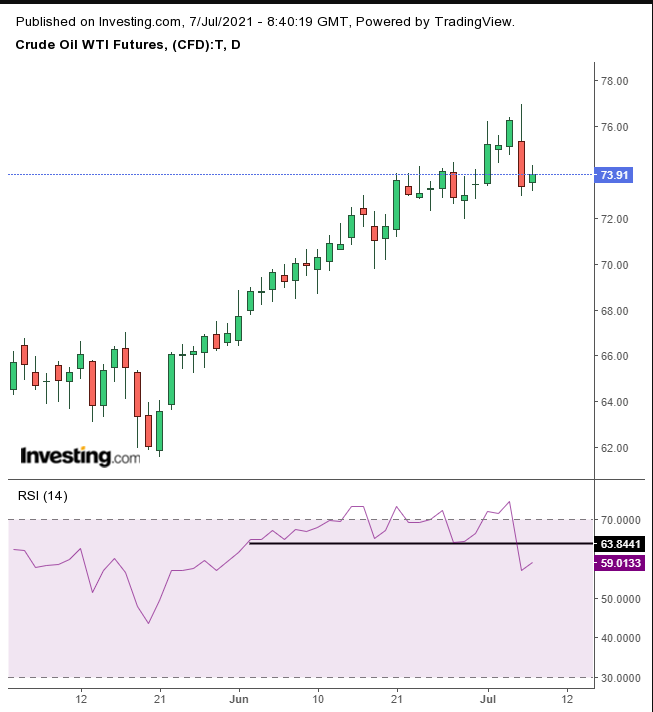
There is some concern that a new price war could start, as it did last year, which was the prelude to the oil market crashing and the price plunging to below $0 which meant oil sellers had to pay buyers $40—an upside-down situation. These conditions were as a result of the lack of space to store oil amid an oversupply.
Yesterday’s selloff was the most powerful for the energy commodity in a long time. The RSI topped out.
